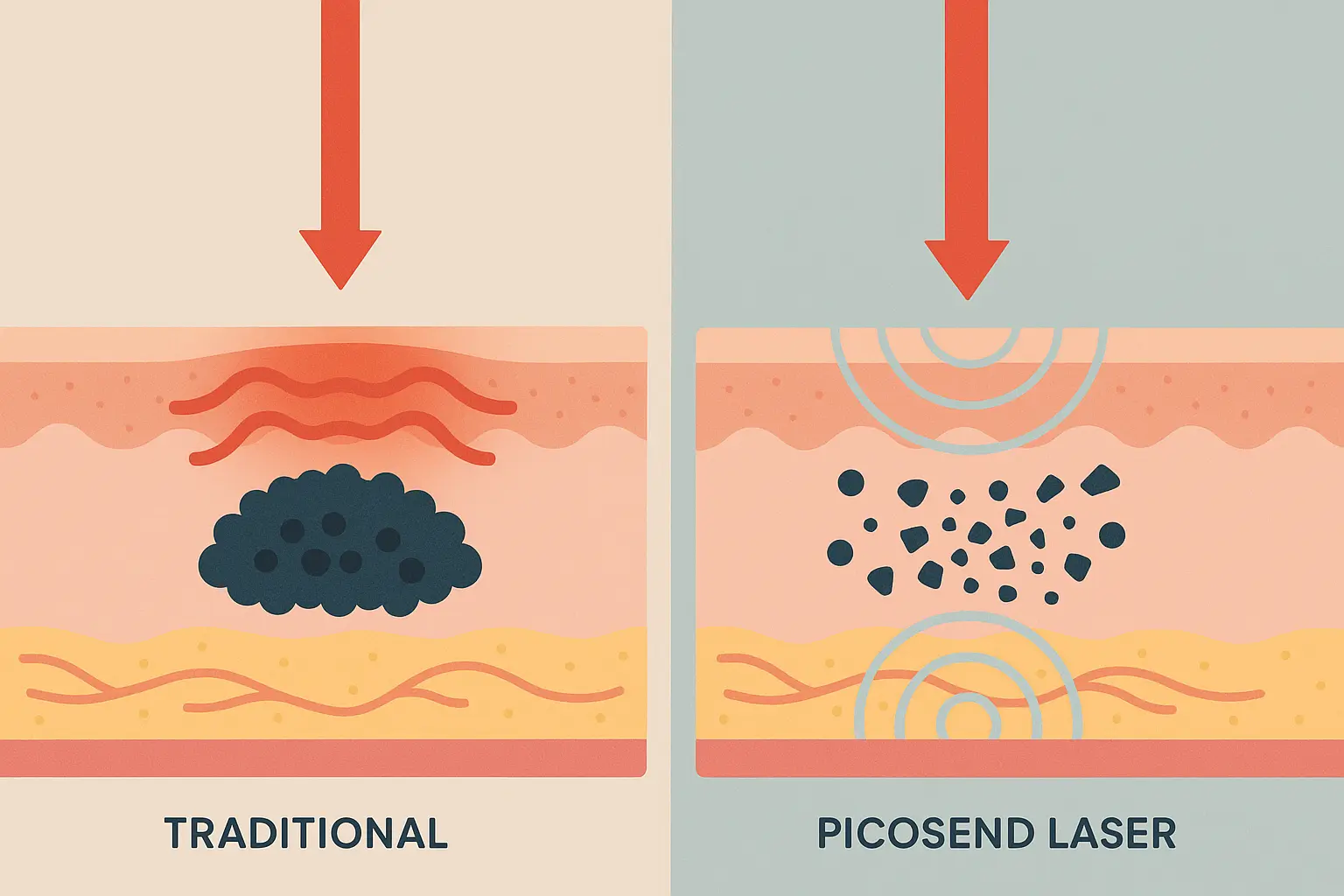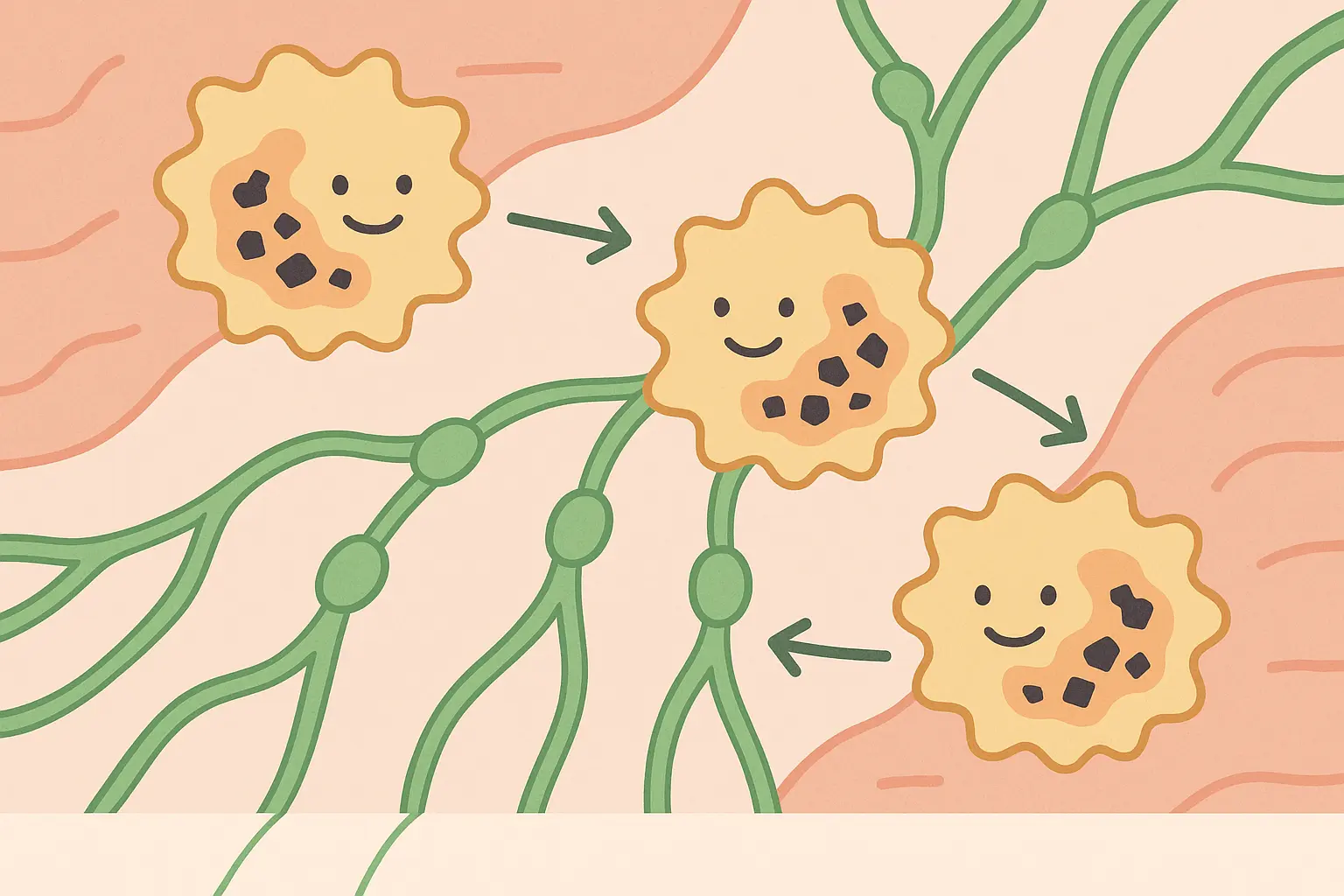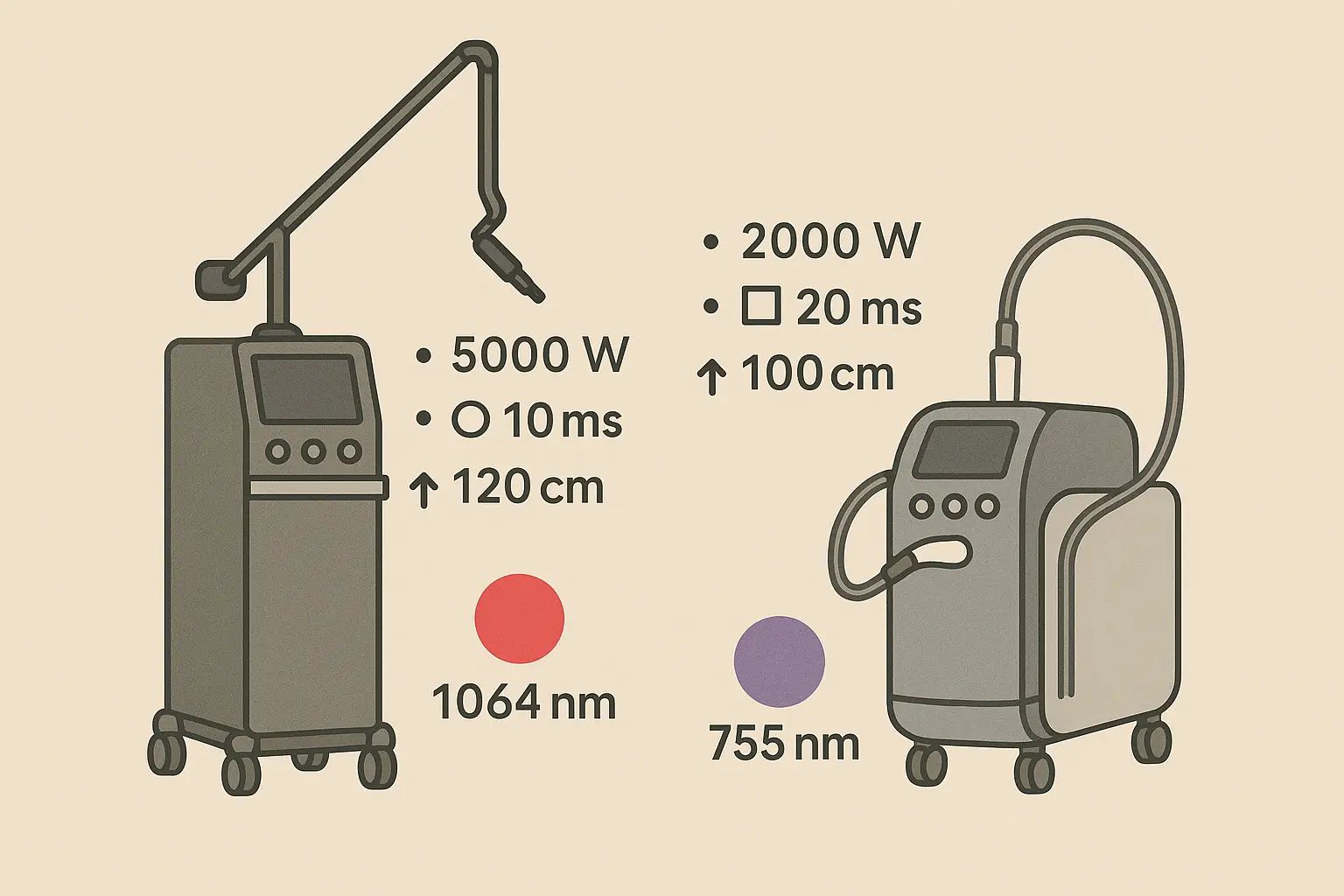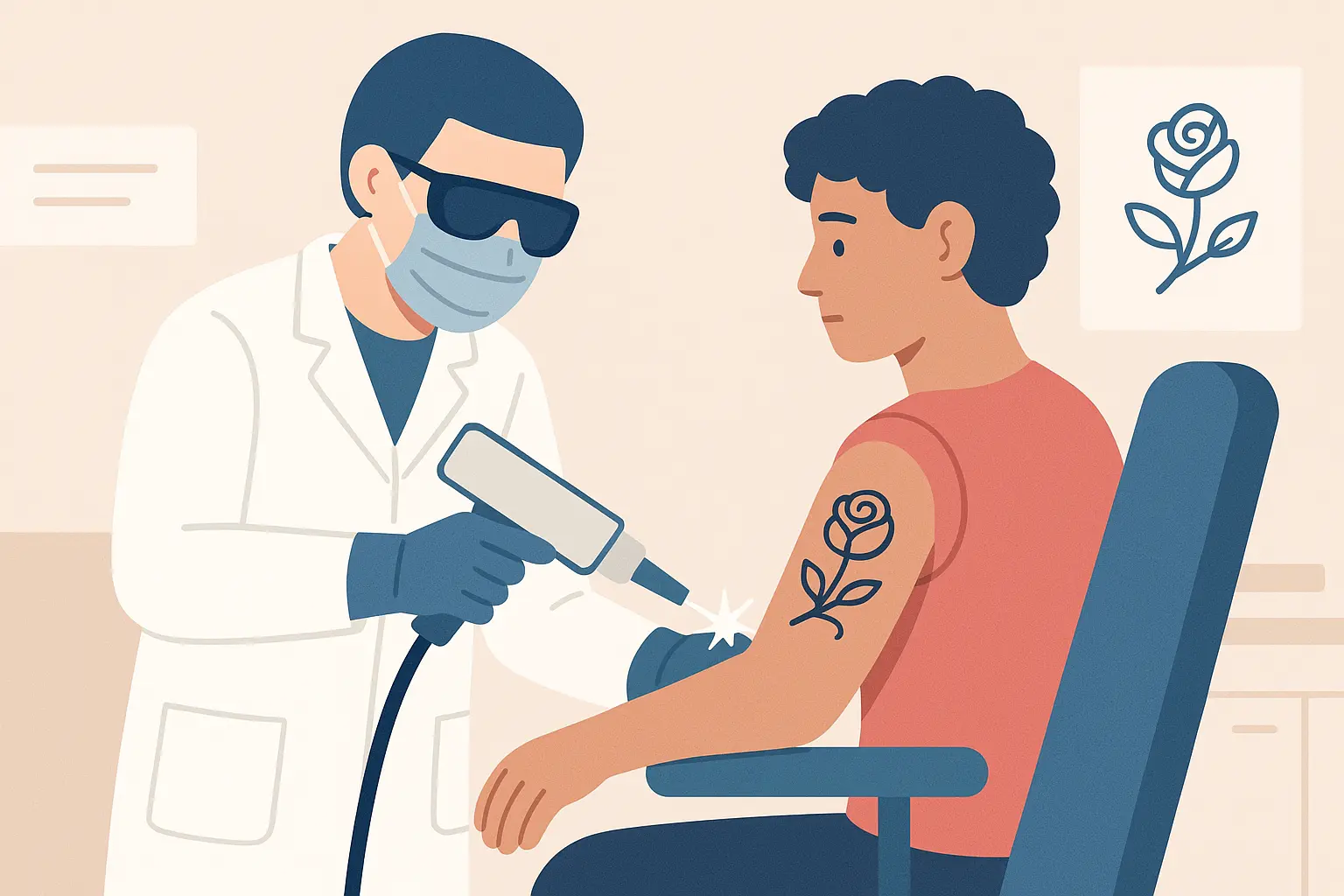Pico Laser Tattoo Removal: What I Wish Someone Had Told Me Before Starting My Journey
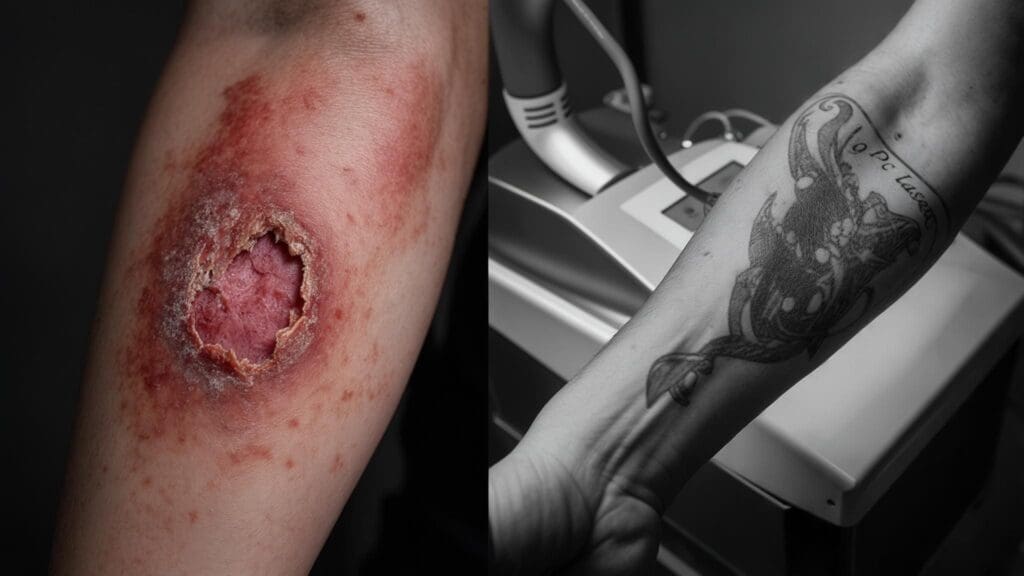
So there I was, staring at my forearm tattoo in the bathroom mirror for probably the hundredth time, wondering how the hell I was going to get this thing off my body. Sound familiar?
With laser tattoo removal becoming increasingly common over the past decade, studies show that approximately 30-40% of adults in the US have at least one tattoo, while 24% of Americans regret one or more of their tattoos according to Allure’s comprehensive tattoo removal guide. This growing regret has fueled demand for the newer laser machines that actually work, and I’m here to share everything I learned during my own removal journey.
I spent months researching before my first appointment, but I still wasn’t prepared for the reality of the process. The technical details, hidden costs, and honest truths about what actually happens during treatment – most clinics won’t tell you this stuff upfront because they want your money. After going through the entire process myself, I want to give you the complete picture.
Table of Contents
-
Okay, Let’s Talk About the Science Stuff (I Promise I’ll Keep It Simple)
-
Beyond the Marketing: What Actually Happens During Treatment
-
Let Me Break Down the Laser Drama (Because Yes, There’s Drama)
-
Your Personal Removal Journey: The Good, Bad, and Zombie Phase
-
Here’s Where Things Get Expensive (And I Mean REALLY Expensive)
-
The Part Where Your Body Does Most of the Work
-
How Not to Screw Up Your Skin (Lessons from My Mistakes)
TL;DR
-
Pico lasers use tiny explosions instead of heat to break up tattoo ink, making them way better than the old-school lasers
-
Different colors need different laser wavelengths – you’ll need the right combo for your specific tattoo
-
Your immune system is basically your cleanup crew that actually removes the broken-up ink
-
Rushing between sessions will slow you down (learned this the hard way)
-
The real cost will make you cry, and insurance definitely won’t help
-
Your age, lifestyle, and genetics matter way more than you think
-
Mess up the aftercare and you’ll regret it for months
Okay, Let’s Talk About the Science Stuff (I Promise I’ll Keep It Simple)
I used to think all laser tattoo removal worked the same way – basically burning the ink out of your skin. Turns out I was completely wrong about picosecond laser technology. These machines work with crazy-fast laser pulses (we’re talking trillionths of a second) and create tiny explosions inside your tattoo instead of just heating everything up.
When the picosecond laser hits the ink, it creates these pressure waves that basically shatter the ink particles from the inside out. Think of it like tiny grenades going off in your tattoo. The best part? This happens without frying your surrounding skin, which is why these treatments hurt less and heal faster than those torture devices they used to call lasers.
How Tiny Explosions Beat the Crap Out of Your Tattoo
Here’s the thing – your body’s cleanup crew (the lymphatic system) has size limits on what it can handle. The smaller fragments that pico lasers create are way easier for your immune cells to grab and haul away. This is why you’ll typically need fewer sessions compared to the older laser systems that basically just cooked your skin.
I learned this the hard way when I started with an older Q-switched laser at a different clinic. After three sessions with basically no progress, I switched to pico and saw dramatic improvement in just two treatments. The difference was like upgrading from a flip phone to an iPhone.
The Color Game: Why Some Inks Are Stubborn Little Jerks
Here’s where it gets technical, but stick with me because this directly affects whether your tattoo will actually disappear or just mock you for years.
Different ink colors absorb different wavelengths of light, and pico lasers can deliver multiple wavelengths to target your tattoo’s specific color palette. My tattoo had this stubborn blue ink that laughed at the first laser I tried. Turns out blue ink is basically the middle child of tattoo removal – needs special attention (and a different wavelength) to actually disappear.
The 532nm wavelength goes after red and orange pigments, 755nm tackles blue and green inks, while 1064nm handles black and dark colors. Most professional tattoos are like a rainbow of different colors, so you’ll likely need a system that can hit multiple wavelengths during the same session.
|
Wavelength |
Target Colors |
Best For |
What Actually Happens |
|---|---|---|---|
|
532nm |
Red, Orange, Yellow |
Warm-toned inks |
Usually fades pretty well |
|
755nm |
Blue, Green, Purple |
Cool-toned inks |
Can be stubborn but works |
|
1064nm |
Black, Dark Blue, Brown |
Dark pigments |
Usually the easiest to remove |
|
Dual wavelength |
Multi-colored tattoos |
Complex designs |
Your best bet for most tattoos |
If you have darker skin, you’ve probably been told that laser tattoo removal is risky for you. While there are definitely more considerations, pico lasers have made the process much safer. The reduced heat generation means less risk of messing with your natural skin pigment, but your practitioner still needs to know what they’re doing and use conservative settings.
I’ve seen too many people with darker skin tones get literally burned by inexperienced practitioners who didn’t adjust their technique properly. Make sure whoever treats you has extensive experience with your skin type, not just good Yelp reviews.
Beyond the Marketing: What Actually Happens During Treatment
Here’s what most people don’t realize: the picoway laser doesn’t actually remove your tattoo. It just breaks up the ink so your immune system can do its job. Your immune cells are the ones that actually grab the fragmented ink particles and carry them away through your body’s drainage system.
This is why your overall health matters so much for treatment success. If your immune system is basically running on fumes, you won’t see good results no matter how fancy the picoway technology is.
Your Immune System Is Doing All the Heavy Lifting
The goal is to create just enough inflammation to call in your body’s cleanup crew without causing permanent damage. Too little inflammation and your immune cells won’t bother showing up. Too much and you risk scarring or weird color changes that last forever.
Experienced practitioners know how to walk this tightrope by adjusting energy levels and treatment patterns based on how your skin responds. This is why your first picoway treatment should always be conservative – they’re basically testing how your body reacts before going full throttle.
Why You Can’t Rush This Process (Even Though You Really Want To)
I wanted my tattoo gone yesterday, so I initially pushed for picoway treatments every 4 weeks. Big mistake. My practitioner explained that your body’s drainage system needs time to clear out all those fragmented ink particles, and your skin needs time to fully heal between sessions.
Most people need 6-12 weeks between picoway sessions, depending on where your tattoo is, how big it is, and how well your body heals. Treatments on areas with good blood flow (like arms) can often be spaced closer together than areas where circulation sucks (like ankles).
Clinical data shows that treatments spaced 6-8 weeks apart are optimal for most patients, with some locations requiring 8-12 week intervals for lower extremities according to Skin Logic Aesthetics clinical guidelines.
Your tattoo’s location dramatically affects how quickly it’ll fade with picoway treatments. Areas with good blood flow and drainage (chest, arms, back) typically respond faster than extremities like hands, feet, and ankles where circulation is basically an afterthought.
I had tattoos on both my forearm and ankle treated at the same time with picoway. The forearm tattoo was 90% gone after 6 sessions, while the ankle tattoo needed 10 sessions for similar results, even though it was smaller and simpler. Circulation matters, people.
Sarah, a 32-year-old teacher, had matching butterfly tattoos on her shoulder blade and ankle. After 8 picoway sessions, her shoulder tattoo was almost completely gone while her ankle tattoo was only 60% faded. The difference in blood flow between these locations meant she needed 4 additional sessions for her ankle tattoo to catch up.
Let Me Break Down the Laser Drama (Because Yes, There’s Drama)
PicoSure was like the iPhone of tattoo removal – first to market, everyone talked about it. What makes picosure laser tattoo removal different is this Focus lens technology that concentrates laser energy into precise patterns instead of just blasting your skin randomly.
The Focus lens creates more effective pressure waves while using less overall energy, which theoretically means less pain and faster healing. In my experience, PicoSure treatments were noticeably less painful than the medieval torture device I tried first.
PicoSure: The OG Pressure Wave Machine
The Focus lens isn’t just marketing fluff – it actually changes how the energy hits your skin. Instead of a uniform beam, it creates a pattern of high-intensity spots that generate stronger pressure waves in the ink while leaving surrounding tissue relatively alone.
This technology works particularly well for stubborn colors and older tattoos where the ink has basically made itself at home in the deeper layers of your skin.
PicoWay: The Overachiever
Picoway laser came later like Android – technically better in some ways, but the marketing wasn’t as flashy. It focuses on ultra-short pulse durations and the ability to deliver multiple wavelengths at the same time. If you have a colorful tattoo that looks like a rainbow exploded on your skin, picoway might be your best bet.
The shorter pulse duration creates even more mechanical stress on ink particles, potentially leading to better fragmentation. However, this also means picoway treatments can be more intense, so pain management becomes way more important.
The difference between 300 and 750 picoseconds might seem like nothing, but it’s huge in laser physics. Shorter pulses create more intense pressure waves with less heat buildup, which should theoretically mean better picoway results with fewer side effects.
In practice, I found picoway treatments more effective on my blue and green ink, but they were definitely more uncomfortable during the actual treatment. The trade-off was worth it for the faster results on those stubborn colors that had been giving me the finger for months.
Your Personal Removal Journey: The Good, Bad, and Zombie Phase
A good consultation involves way more than just eyeballing your tattoo and throwing out a price for pico laser tattoo removal. Your practitioner should be asking about when you got the tattoo, what type of ink was used (if you even know), any previous removal attempts, your medical history, medications, and lifestyle factors.
Professional tattoos typically respond better than amateur ones because the ink is usually applied more consistently and at predictable depths. Older tattoos (over 2 years) often remove easier because your immune system has already started breaking down some of the ink naturally.
The Real Assessment: Way More Than Just Looking at Your Ink
What They Should Actually Be Asking You:
-
Your complete medical history (medications, skin conditions, allergies)
-
When and where you got the tattoo
-
Any previous removal attempts that failed miserably
-
Your skin type and how it typically heals
-
Lifestyle factors (smoking, sun exposure, how often you exercise)
-
What your realistic timeline actually is
-
How much money you can actually afford to spend
-
Whether you understand that aftercare isn’t optional
Amateur tattoos can be tricky because the ink depth is all over the place, and cheaper inks sometimes contain metals that basically flip off picoway treatment. I’ve seen people struggle with removing simple stick-and-poke tattoos that should have been easy cases.
Professional tattoos, while often more complex, tend to respond more predictably to picoway because the ink was applied consistently and the artist likely used higher-quality pigments that don’t contain mystery ingredients.
Clinical studies show that all patients in clinical studies achieved greater than 75% tattoo clearance, with 78% obtaining almost complete removal using picosecond laser technology according to Journal of the Korean Society for Laser Medicine and Surgery.
Nobody Warns You About the Zombie Phase
Here’s something weird nobody mentions: your tattoo will look WORSE before it looks better. Like, way worse. For weeks. I thought I’d made a terrible mistake until my friend who’d been through it was like, “Oh yeah, the zombie phase. Totally normal.”
Good clinics use standardized photography with controlled lighting to track your picoway progress objectively. Some even use computer analysis to measure fading percentages, which helps determine if treatment parameters need adjustment.
Don’t rely on your memory or random phone photos to judge progress. Tattoo fading happens gradually, and it’s easy to get discouraged if you’re not seeing dramatic changes between picoway sessions.
Almost everyone hits a plateau where picoway progress seems to stall for 2-3 sessions. This is normal and doesn’t mean the treatment stopped working. Sometimes your immune system needs time to catch up, or deeper ink layers
Almost everyone hits a plateau where picoway progress seems to stall for 2-3 sessions. This is normal and doesn’t mean the treatment stopped working. Sometimes your immune system needs time to catch up, or deeper ink layers are becoming accessible as surface layers clear.
Don’t panic and don’t push for more aggressive picoway settings during plateaus. Patience usually pays off, and the fading often picks up speed again after a few sessions.
Mike’s tribal sleeve tattoo showed dramatic 60% fading in the first 4 sessions, then seemed to stall for sessions 5-7 with basically no visible change. His practitioner kept the same settings, and sessions 8-10 showed renewed progress, ultimately achieving 90% clearance. The plateau happened as deeper ink layers became accessible for treatment.
Here’s Where Things Get Expensive (And I Mean REALLY Expensive)
Picoway laser machines cost anywhere from $150,000 to $400,000, and clinics need to perform thousands of treatments annually just to break even on equipment costs. This is why prices are all over the map – some clinics are trying to recoup their investment quickly, while others use removal as a loss leader to get you in the door for other services.
Don’t automatically assume the most expensive clinic is the best, but be wary of prices that seem too good to be true. Quality picoway laser treatment requires serious investment in equipment, training, and ongoing maintenance.
Here’s the Part That’s Going to Hurt Worse Than the Laser
Insurance almost never covers picoway tattoo removal because it’s considered cosmetic. However, I’ve seen a few cases where people got partial coverage for medical reasons – severe allergic reactions to the ink or job requirements (military, healthcare workers).
If you think you might have a medical case, get documentation from your doctor before starting picoway treatment. Even then, coverage is rare and usually partial.
The Real Money Talk Nobody Wants to Have
Session fees are just the beginning. I budgeted like I was buying a used car, but ended up spending like I was buying a decent used car. And that’s WITH doing my research.
For my medium-sized forearm tattoo, I budgeted $2,000 for removal but ended up spending closer to $3,200 when I included everything. The extra costs came from premium aftercare products, parking fees for downtown appointments, and two additional sessions beyond the initial estimate.
Pro tip I learned after overspending: That fancy numbing cream they sell you? Amazon has the same stuff for half the price. Don’t ask me how I know this.
|
Cost Category |
What You’ll Actually Spend |
My Reality Check |
The Fine Print |
|---|---|---|---|
|
Session fees (6-10 sessions) |
$1,500-$4,000 |
$2,400 |
Plan for the high end |
|
Aftercare products |
$100-$300 |
$180 |
Quality matters for healing |
|
Time off work |
$200-$800 |
$320 |
Depends on your job flexibility |
|
Transportation/parking |
$50-$200 |
$150 |
Urban clinics cost more |
|
Additional sessions |
$0-$1,000 |
$500 |
20% of people need extras |
|
Total Investment |
$1,850-$6,300 |
$3,550 |
Seriously, plan for the upper range |
When they say “6-12 sessions,” your brain hears “maybe 6.” Plan for 12. Actually, plan for 15. Thank me later when you’re not crying into your credit card statement.
The Part Where Your Body Does Most of the Work
Your age affects everything about tattoo removal. People over 40 typically see 25-30% slower ink clearance because your body’s drainage system slows down with age, and your immune cells aren’t as energetic as they used to be.
This doesn’t mean older patients can’t get great picoway results – it just takes longer and might require more sessions. If you’re over 50, plan for extended treatment timelines and don’t get discouraged if younger people in online forums are seeing faster progress.
Age Isn’t Just a Number (Unfortunately)
Look, I’m not going to lecture you about lifestyle choices, but I will tell you that smoking is the biggest factor that kills tattoo removal results. We’re talking 40-50% reduced effectiveness through blood vessel constriction and messed-up immune cell function. If you smoke, seriously consider quitting before starting treatment.
Alcohol, poor diet, and lack of exercise also slow down the process, but not as dramatically as smoking. Regular exercise actually helps by improving your body’s drainage and circulation.
Real Talk Optimization List:
-
Quit smoking at least 4 weeks before treatment (yes, really)
-
Limit alcohol during treatment periods
-
Keep up regular exercise for better drainage
-
Stay hydrated (8+ glasses water daily)
-
Eat anti-inflammatory foods (leafy greens, fish, berries)
-
Get decent sleep for immune function
-
Manage stress levels however works for you
The Genetic Lottery You Can’t Control
Some people are just genetic lottery winners when it comes to tattoo removal. They have robust immune systems, excellent drainage, and skin that heals beautifully without complications. Others struggle despite doing everything right.
You can’t change your genetics, but understanding your family history of healing, scarring, and immune responses can help set realistic expectations. If your family tends to scar easily or has autoimmune issues, discuss this with your practitioner upfront.
Research shows that all patients in clinical studies achieved greater than 75% tattoo clearance, with 78% obtaining almost complete removal using picosecond laser technology according to Journal of the Korean Society for Laser Medicine and Surgery.
Jennifer, a 28-year-old with excellent health, achieved 85% fading of her black ankle tattoo in just 4 sessions. Her identical twin sister Lisa, who smoked and had a sedentary lifestyle, needed 8 sessions for 70% fading of a similar tattoo. Genetics provided the foundation, but lifestyle choices made a huge difference in outcomes.
How Not to Screw Up Your Skin (Lessons from My Mistakes)
Dark spots where your tattoo used to be (hyperpigmentation) is still the most common complication, even with pico lasers. It happens when your pigment-producing cells get overstimulated by the treatment or sun exposure afterward.
Sun protection isn’t optional – it’s like wearing a seatbelt. You might get away with skipping it once or twice, but when you don’t, the consequences suck. I have a friend with permanent dark spots who learned this the expensive way.
I’m talking SPF 50+ reapplied every 2 hours, protective clothing, and avoiding peak sun hours entirely for at least 6 weeks before and after each treatment. I learned this lesson the hard way when I got lazy with sunscreen and ended up with dark patches that took 8 months to fade.
The Dark Spot Trap That Gets Everyone
If you have darker skin or a history of hyperpigmentation, ask about pre-treatment with hydroquinone or tretinoin. Starting these 4-8 weeks before your first laser session can significantly reduce your risk of developing dark spots.
Your dermatologist might also recommend specific skincare routines to optimize your skin barrier function before treatment begins.
Scarring: Rare But It’ll Ruin Your Life
Scarring is rare with pico lasers, but it does happen. People with a family history of keloids or raised scarring need to be extra careful. If you’ve ever had raised scars from cuts, piercings, or surgery, make sure your practitioner knows this.
Conservative treatment settings and longer healing intervals are essential for high-risk patients. It’s better to need an extra session or two than to end up with permanent scarring where your tattoo used to be.
Any reputable practitioner should offer to do a small test spot before treating your entire tattoo, especially if you have risk factors for complications. This involves treating a small area and waiting 4-6 weeks to see how your skin responds.
I wish I’d insisted on this for my first treatment. The practitioner went straight to treating my entire tattoo, and while I didn’t have complications, the peace of mind would have been worth the extra visit.
What Your Practitioner Should Actually Be Doing:
-
Screening for scarring tendencies in your medical history
-
Test spot treatment for high-risk patients
-
Conservative initial settings (they can always go higher later)
-
Proper eye protection during treatment
-
Sterile technique and equipment
-
Emergency protocols for when things go wrong
-
Clear aftercare instructions that make sense
-
24-hour contact availability for concerns
Recent industry developments show promising growth in tattoo removal services. Think Again Tattoo Removal opened in South Austin in May 2025, reflecting the expanding market for advanced removal technologies and increasing consumer demand for professional services.
The Bottom Line
Look, I’m not going to sugarcoat this: tattoo removal is a pain in the ass. It’s expensive, time-consuming, and sometimes frustrating. Pico laser technology is genuinely impressive and has made the process safer, faster, and more effective than ever before. But it’s still a significant commitment of time, money, and patience that shouldn’t be taken lightly.
The key to success lies in understanding that this isn’t just about pointing a laser at your skin – it’s about working with your body’s natural processes, choosing the right technology and practitioner, and having realistic expectations about timelines and outcomes.
Nobody warns you about the weird grief you feel watching your tattoo slowly fade. Even when you want it gone, there’s this strange sadness as pieces of your past literally disappear from your skin. Instagram will show you perfect before-and-after photos. Real life will show you a slow, sometimes frustrating process that looks like nothing is happening for weeks at a time. Both are true.
Most importantly, remember that the best tattoo removal is the one you never need. Whether you’re considering your first tattoo or adding to your collection, taking time to make thoughtful decisions about design, placement, and artist selection will serve you much better than having to undo those choices later.
If you do decide to move forward with removal, find a practitioner who takes the time to educate you, uses proper assessment protocols, and prioritizes your safety over quick profits. Don’t go with the cheapest option, but don’t assume the most expensive is automatically the best either. Your skin will thank you for doing your homework.
Just go in with your eyes wide open, find someone who knows what they’re doing, and be patient with the process. And maybe start saving money now, because it’s going to cost more than you think.

